How to Care for Anthurium: A Comprehensive Guide
Anthurium, also known as the flamingo flower, is a popular houseplant that adds a touch of tropical beauty to any indoor space. With its bright, heart-shaped flowers and glossy leaves, anthurium is a favorite among plant enthusiasts. However, caring for anthurium can be a bit tricky, as it requires specific conditions to thrive.
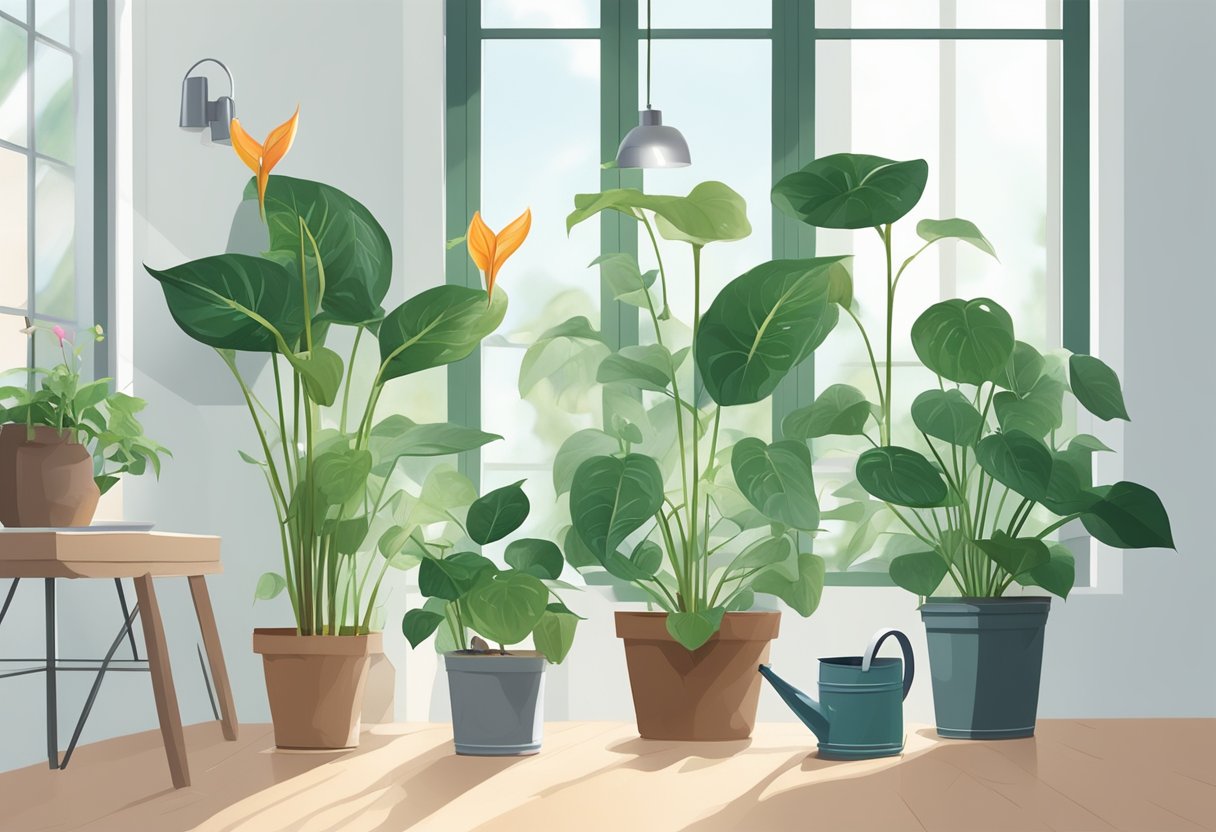
To keep anthurium healthy and vibrant, it is essential to provide it with the right amount of light, water, and nutrients. This tropical plant prefers bright, indirect light and should be kept away from direct sunlight, which can scorch its leaves. Anthurium also requires consistently moist soil, but overwatering can lead to root rot. Fertilizing with a balanced houseplant fertilizer every two to four weeks during the growing season can help promote healthy growth and flowering.
Overall, caring for anthurium requires a bit of attention to detail, but with the right care, this beautiful tropical plant can thrive as a stunning addition to any indoor space.
Understanding Anthurium Basics
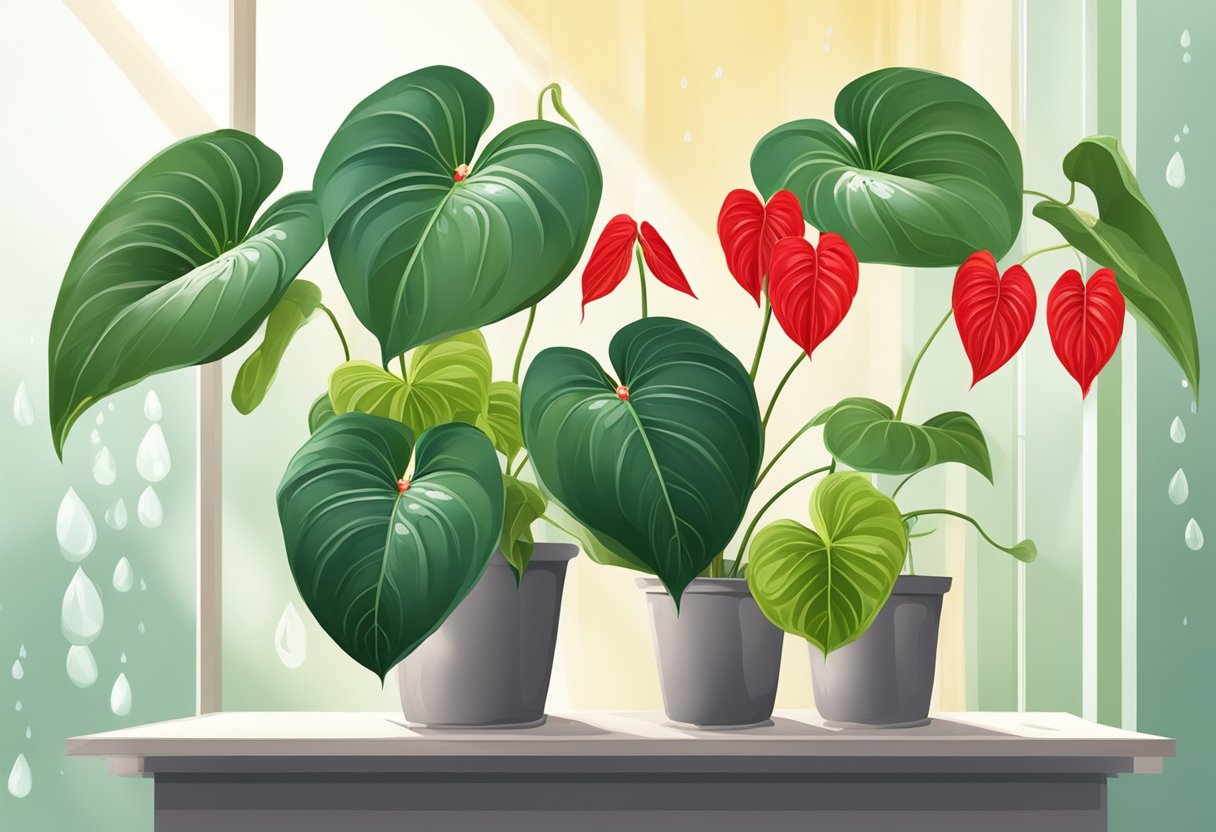
Varieties of Anthurium
Anthurium is a genus of flowering plants that includes more than 1000 species. The most commonly cultivated species are Anthurium andraeanum and A. scherzerianum. Other popular species include A. jenmanii, A. crystallinum, and A. clarinervium.
Anthurium plants come in a wide range of colors, including red, pink, orange, yellow, white, and green. Some varieties have variegated leaves or spathes with multiple colors.
Anthurium Botanical Characteristics
Anthurium plants are known for their heart-shaped leaves and showy blooms. The blooms are actually modified leaves called spathes, which can be red, pink, orange, or white. The spathes surround a cylindrical structure called a spadix, which contains the actual flowers.
The leaves and spathes of anthurium plants are glossy and waxy, which helps them retain moisture. Anthurium plants are native to tropical regions, so they prefer warm, humid conditions. They also require well-draining soil and bright, indirect light.
Anthurium plants are easy to care for, but they do require some attention to thrive. Regular watering and fertilizing can help keep the plant healthy and promote blooming. It’s also important to keep an eye out for pests, such as spider mites and mealybugs, which can damage the plant.
Overall, understanding the basics of anthurium care can help ensure that your plant stays healthy and vibrant for years to come.
Optimal Growing Conditions
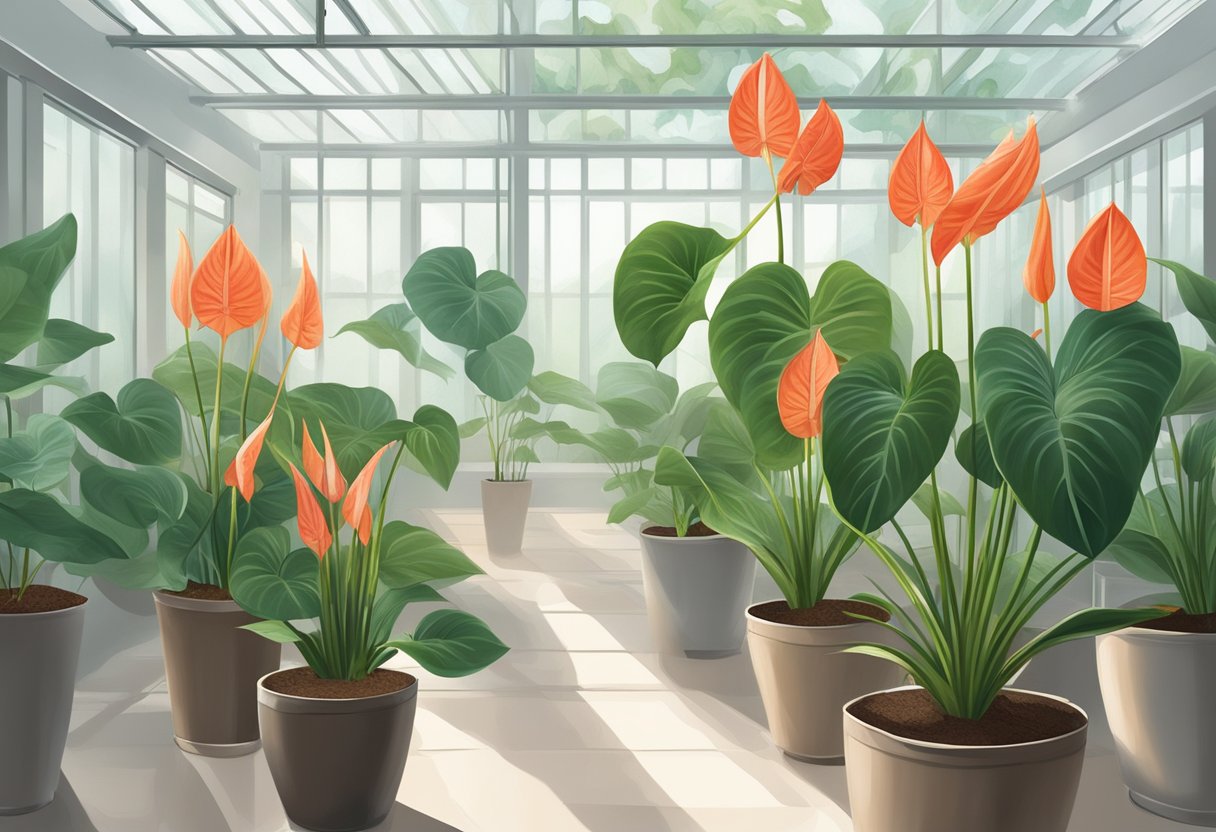
Light Requirements
Anthurium plants thrive in bright, indirect light. They should be placed near a window that receives plenty of sunlight but not direct sun, as direct sun can scorch the leaves. If the plant is not receiving enough light, the leaves may turn yellow or brown and the plant may stop producing flowers.
Temperature and Humidity
Anthurium plants prefer warm temperatures and high humidity. They should be kept in an environment with a temperature range of 60-90°F (15-32°C) and a humidity level of at least 60%. In the summer, the plant may benefit from being placed in a shaded area outside, as long as it is protected from direct sun and strong winds.
Soil and Potting Mix
Anthurium plants require well-draining soil that is rich in organic matter. A good potting mix for anthuriums is one that contains peat moss, perlite, and well-draining soil. It is important to ensure that the pot has drainage holes to prevent water from accumulating at the bottom, which can lead to root rot.
Overall, anthurium plants are relatively easy to care for as long as their basic needs are met. By providing them with the optimal growing conditions of bright, indirect light, warm temperatures, high humidity, and a well-draining potting mix, they can thrive and produce beautiful flowers.
Anthurium Care and Maintenance
Anthuriums are beautiful plants that are easy to care for. Here are some tips for keeping your anthurium healthy and thriving.
Watering Schedule
Anthuriums prefer to be kept evenly moist, but not waterlogged. It is best to water them when the top inch of soil feels dry to the touch. During the growing season (spring and summer), they may require more frequent watering. Be sure to use water that is at room temperature and avoid getting water on the foliage, as this can cause leaf spots.
Fertilizing Your Anthurium
Anthuriums benefit from regular fertilization during the growing season. A balanced fertilizer with equal amounts of nitrogen, phosphorus, and potassium is ideal. Fertilize every two weeks with a diluted solution, following the manufacturer’s instructions. Be careful not to over-fertilize, as this can cause root burn and damage the plant.
Pruning and Cleaning
Pruning spent flowers and yellow or damaged leaves will help keep your anthurium looking its best. Use a clean, sharp pair of scissors or pruning shears to make clean cuts. Wipe the blades with rubbing alcohol between cuts to prevent the spread of disease. Dust the leaves regularly with a soft cloth to keep them clean and free of pests.
Remember to repot your anthurium every two to three years, using a well-draining potting mix. If your plant has outgrown its container, it may be time to divide it into smaller sections. Be sure to provide adequate drainage by adding a drainage hole to the bottom of the pot or using a plastic pot with drainage holes.
By following these simple care and maintenance tips, your anthurium will thrive and reward you with beautiful flowers and foliage.
Propagation Techniques
Anthurium can be propagated through division and stem cuttings. Both methods are effective, and the choice of technique depends on the plant’s size and health.
Division
Division is the process of separating anthurium into smaller plants. This technique is useful when the plant has outgrown its pot or when it has multiple stems. To propagate through division, follow these steps:
- Remove the plant from its pot and gently shake off the excess soil.
- Inspect the roots and look for natural divisions or stems with their own root systems.
- Use a sharp, clean knife to separate the root ball into smaller sections.
- Plant each new section in its own pot with fresh potting soil.
Stem Cuttings
Stem cuttings are a simple and effective way to propagate anthurium. This technique is useful when the plant has a single stem or when it is difficult to divide the root ball. To propagate through stem cuttings, follow these steps:
- Choose a healthy stem with at least two leaves.
- Use a sharp, clean knife to cut the stem just below a node.
- Remove the bottom leaf and any flowers or flower spikes.
- Dip the cut end of the stem in rooting hormone.
- Plant the stem in a pot with fresh potting soil and water well.
Propagation is a great way to increase your anthurium collection or share your plants with others. With these techniques, you can easily create new plants from cuttings or divisions.
Common Pests and Diseases
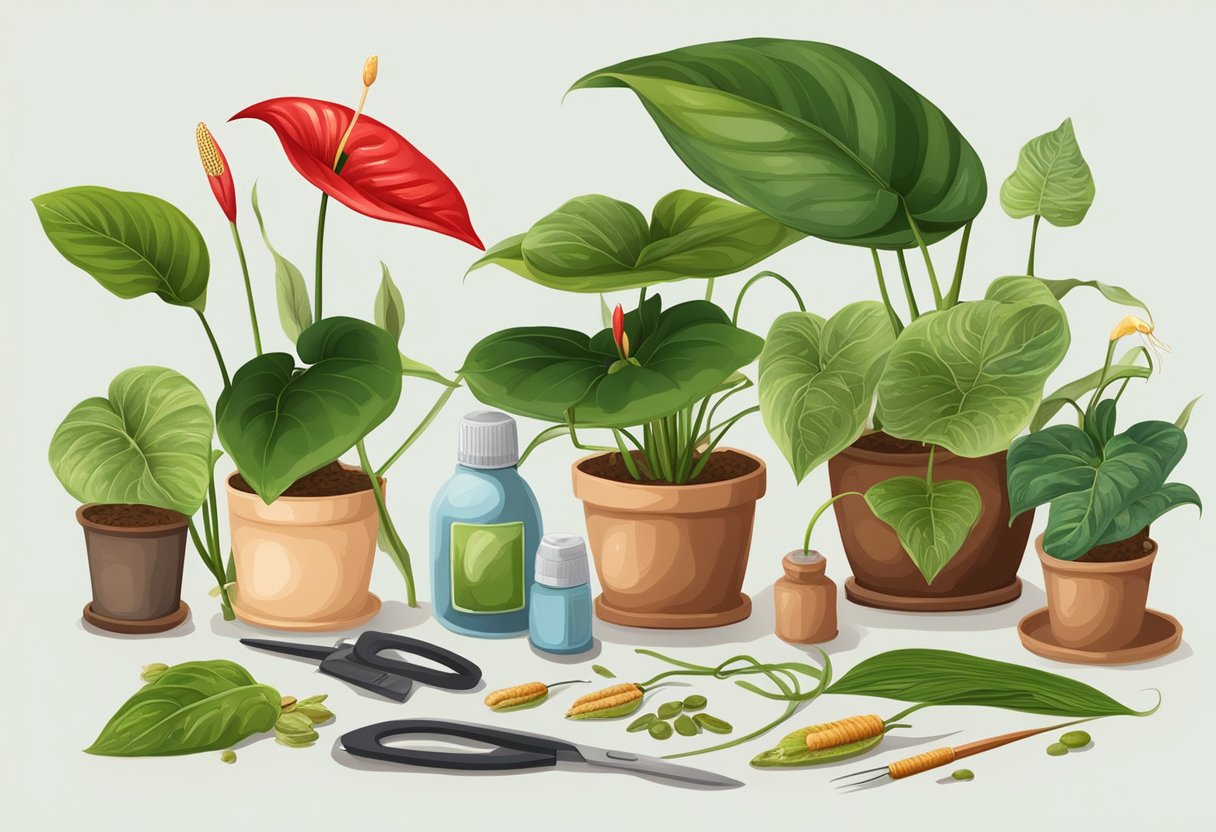
Pest Management
Anthurium plants are relatively pest-resistant, but they can still fall prey to a few common pests. Spider mites are one of the most common pests that can infest anthuriums. These tiny insects can be identified by the fine webbing they leave behind on the plant. To manage spider mites, regularly mist the plant with water to increase humidity levels and use insecticidal soap or neem oil to kill off any remaining pests.
Another common pest that can affect anthuriums is mealybugs. These small, white insects can be found on the undersides of leaves and near the stem of the plant. To manage mealybugs, use a cotton swab dipped in rubbing alcohol to remove the insects from the plant. Be sure to check the plant regularly for any signs of reinfestation.
Disease Prevention
Anthurium plants can be susceptible to a few common diseases, including root rot. Root rot is caused by overwatering or poor drainage and can cause the plant’s roots to become mushy and discolored. To prevent root rot, make sure the plant is potted in well-draining soil and allow the top inch of soil to dry out before watering again.
Another disease that can affect anthuriums is bacterial blight. This disease is characterized by brown spots on the leaves and a foul odor emanating from the plant. To prevent bacterial blight, avoid overhead watering and make sure the plant has good air circulation.
Overall, with proper care and attention, anthurium plants can remain healthy and vibrant for years to come. Regularly inspecting the plant for any signs of pests or diseases and taking swift action when necessary can help ensure the plant’s longevity.
Anthurium Display and Aesthetics
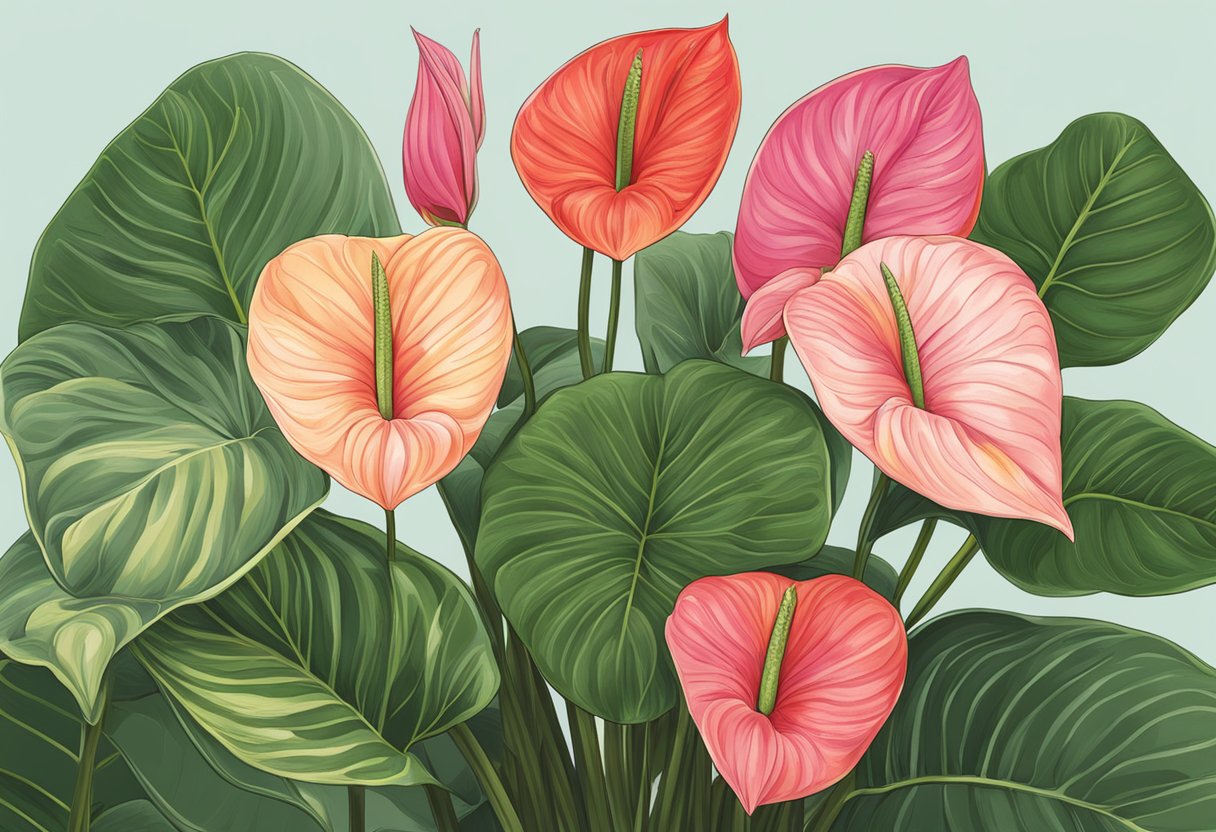
Choosing the Right Location
When it comes to displaying anthuriums, it’s important to choose the right location. These plants thrive in bright, indirect light, so it’s best to place them near a window that doesn’t receive direct sunlight. If you’re unsure about the amount of light in a particular area, you can use a light meter to measure it.
Anthuriums also prefer a warm, humid environment. They do well in bathrooms or other areas with high humidity. If your home is particularly dry, you can place a humidifier near your anthurium to keep it happy.
Color Schemes and Variations
Anthuriums come in a variety of colors, including white, red, pink, yellow, orange, purple, and even black. When choosing a color scheme for your anthurium display, it’s important to consider the other colors in the room. You can create a cohesive look by choosing anthuriums that complement or contrast with the existing colors.
For example, if you have a predominantly white room, a bright red anthurium can add a pop of color. On the other hand, if you have a room with warm, earthy tones, a pink anthurium can create a harmonious feel.
In addition to color, you can also consider the size and shape of your anthuriums. Flamingo lilies, for example, have large, showy blooms that can make a statement in any room. Smaller anthuriums, on the other hand, can be grouped together to create a more dynamic display.
Overall, when it comes to anthurium display and aesthetics, it’s important to consider the plant’s needs while also creating a look that complements your existing decor. With the right location, color scheme, and variations, your anthuriums can add beauty and style to any room.
Safety and Precautions

Toxicity to Pets and Humans
Anthurium plants are toxic to both pets and humans. The plant contains calcium oxalate crystals, which can cause irritation and swelling in the mouth, tongue, and throat if ingested. In severe cases, it can lead to difficulty breathing and even death.
It is important to keep anthurium plants out of reach of children and pets. If you have pets, it is recommended to keep them away from the plant or to supervise them when they are near it. In case of accidental ingestion, seek medical attention immediately.
When handling anthurium plants, wear gloves to avoid skin irritation. If you come into contact with the sap or juice of the plant, wash the affected area with soap and water immediately.
In summary, anthurium plants should be handled with care due to their toxicity to pets and humans. Keep them out of reach of children and pets, wear gloves when handling them, and seek medical attention in case of accidental ingestion.
Frequently Asked Questions
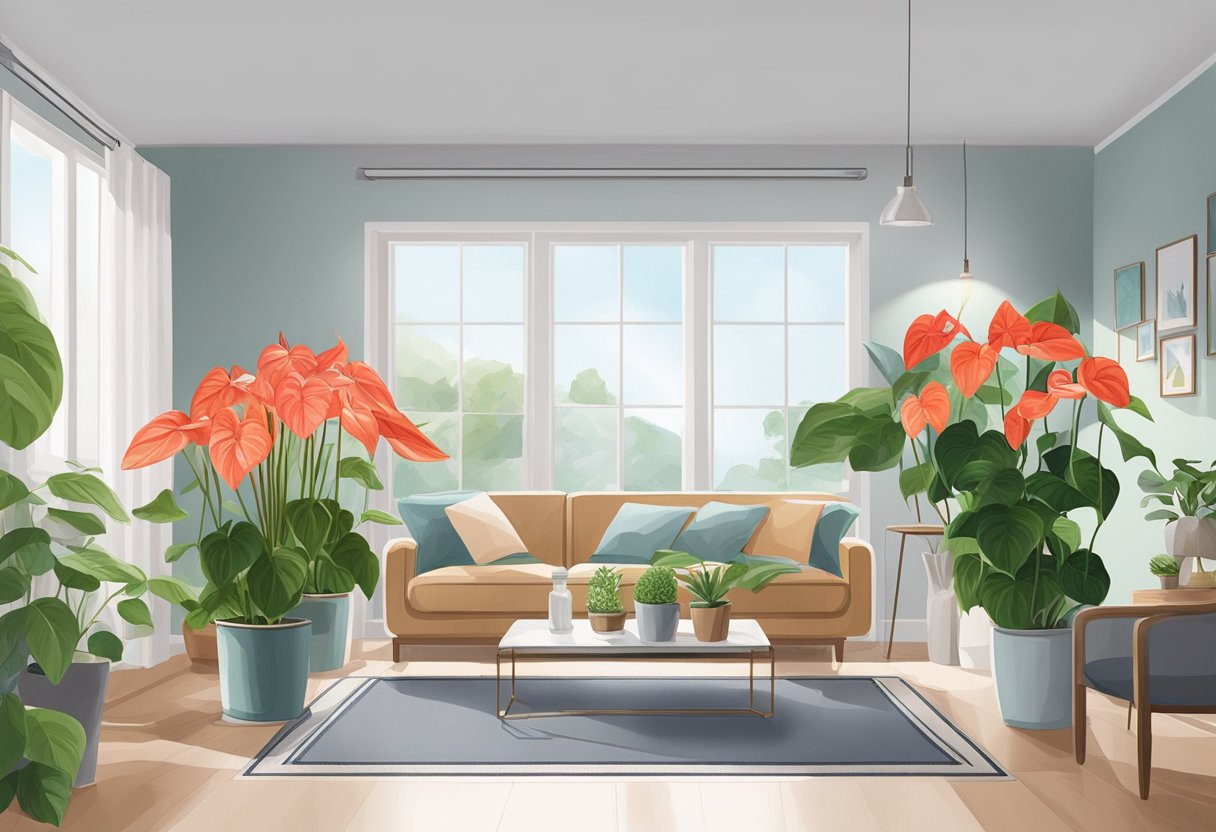
What type of soil is best for potting anthuriums?
Anthuriums prefer well-draining soil that is rich in organic matter. A mix of peat moss, perlite, and vermiculite is ideal for potting anthuriums. The pH level of the soil should be slightly acidic, between 5.5 and 6.5. Avoid using heavy soil that retains water as it can cause root rot.
How should I care for my anthurium during the winter months?
Anthuriums are sensitive to cold temperatures and should be kept in a warm, humid environment. The ideal temperature range for anthuriums is between 60 and 90 degrees Fahrenheit. During the winter months, it is important to keep the plant away from drafts and cold windows. It is also recommended to mist the leaves with water to increase humidity levels.
What are common issues with anthurium plants and how can I address them?
Common issues with anthuriums include root rot, yellowing leaves, and pests such as spider mites and mealybugs. To prevent root rot, ensure proper drainage and avoid overwatering. Yellowing leaves may be a sign of underwatering or exposure to direct sunlight. To address pests, use a mild insecticide or wipe the leaves with a damp cloth.
How often is watering required for indoor anthurium plants?
Anthuriums require regular watering, but it is important to avoid overwatering as it can lead to root rot. Water the plant when the top inch of soil feels dry to the touch. During the winter months, reduce watering frequency as the plant’s growth slows down.
What is the ideal location to place an anthurium in my home?
Anthuriums thrive in bright, indirect light. Avoid placing the plant in direct sunlight as it can scorch the leaves. A north or east-facing window is ideal for anthuriums. The plant can also be placed in a shaded area outdoors during the summer months.
Which fertilizer is recommended for healthy anthurium growth?
Anthuriums require a balanced fertilizer with equal amounts of nitrogen, phosphorus, and potassium. A 10-10-10 fertilizer is recommended for healthy anthurium growth. Fertilize the plant every 2-3 months during the growing season (spring and summer) and reduce frequency during the winter months.
